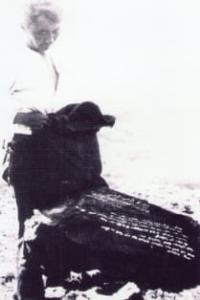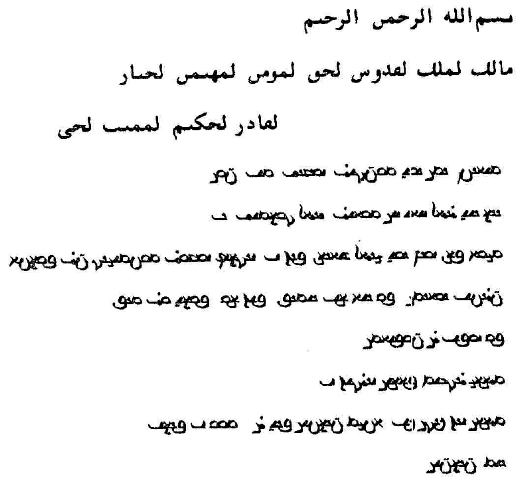You are here
Monument to the famous campaign.

Historical events in Ulytau.
"1. bi-smi-llahi-r-raxmani-r-raxim
2. māliku-l-mulki-l-quddusu-l-x̣akqu-l-mu’minu-l-muhayminu-l-jabbār.
3. l-kādiru-l-xakimu-l-mumitu-l-xaiyu.
4. tarïq jeti jüz toqsan üčintä qoj.
5. jïl jaznïŋ ara aj turannïŋ sultanï.
6. temür beg üč jüz miŋ čerig bilä islam üčün toqtamïš qan bulγar.
7. qanïqa jorïdï bu jerkä jetip belgü bolzun tip.
8. bu obanï qopardï.
9. täŋri nïsfät bergäj inšala.
10. täŋri il kišigä raqmat qïlqaj bizni duu-a bilä.
11. jad qïlqaj"
Transcription of the text of Timur's bilingual inscription.
“In the country of seven hundred black Tokmaks per sheep year, in the middle spring month, Sultan Temurbek of Turan marched with two hundred thousand troops, in the name of Islam, for the blood of Toktamysh Khan (Bulgar). Having reached this, he erected this Mound so that it would be a sign. May God provide justice! If God wills it! May God show mercy to people! May he remember us with mercy!”
Inscription on a dark amphibolite slab. Eleven lines. Three of them are written in Arabic script and contain Quranic text. The rest are written in characters of the Uyghur alphabet.
Tamerlane's campaign to Ulytau.
One of the interesting sights of Ulytau is the Altynshoky hill. Everyone who has the opportunity to visit Ulytau must visit this historical place. What is it famous for? Let's start, perhaps, from afar. From 1711 to 1721, the captured Swedish officer Philip Stralenberg lived in Tobolsk, who collected a lot of material on the history, geography and topography of Central Kazakhstan. In 1723, having returned to his homeland, F. Stralenberg began to write a book in which he reported on writings on stone in the Edyge Mountains.
Apparently, we are talking about the famous Ulytau inscription, known as “karsakpai” and discovered in 1935 on the top of Mount Altyn by Kanysh Imantaevich Satpayev. This stone slab is currently kept in the city on the Neva, in the Hermitage.
According to scientists, it was erected in 1391 during Tamerlane’s famous campaign against the Golden Horde. It is known from history that in the 40s of the XIVth century the power of the khans from the Chinggis family ceased in the Jagatai state.
The latter fell in the fight against his vassals - the ulus emirs, who seized power. Among them, the owner of Samarkand, Emir Hussein, stood out. But soon he had a rival in the person of another emir - Timur, the head of the Turkic family of Barlas in the Kashka Darya valley. Initially, Timur was the leader of a military squad.
Then he entered into an alliance with Hussein and, in a joint campaign with him, was wounded in the leg, and became lame for life and therefore received the nickname Timur Leng - the Iron Lame, converted by Europeans into Tamerlane.
In 1388, Tamerlane's vassal, Khan of the Golden Horde Tokhtamysh, rebelled against his overlord, which served as a signal for an uprising in Khorezm. Timur invaded Khorezm for the fifth time, devastated it, destroyed the capital Urgeng to the ground and even ordered the place on which it stood to be plowed and sowed with barley.
Then Timur went on a campaign against Tokhtamysh Khan. It was during this campaign that the so-called “Karsakpai inscription of Timur” appeared. This was in 1391.
Nizam-ad-din Shami gives a more precise date; he not only gives the year, but the month and day - the 23rd day of the month of Jumadi I, i.e. April 28, 1391 Timur calls himself in the inscription the Sultan of Turan.
The inscription also indicates the number of Timur's troops - 200,000 people, which confirms the correctness of the information of Giyas-ad-din Ali, Nizam-ad-dn Shami, Sheref-ad-din Ali Iezdi and other sources about the size of Timur's army when describing this or that from his campaigns.
The inscription indicates the purpose of the campaign - Timur is going against Tokhtamysh Khan. Timur did not choose the shortest path to the camp of his enemy. Either he wanted to attack Tokhtamysh from the side from which he least expected him, or he was at the same time planning to expand his possessions by seizing new lands - be that as it may, he, moving with his army along the banks of Seykhun (Syr Darya) on the second of April ( May) reached the Saryozen (Sarysu) River.
Before his eyes lay the endless steppe, the ancient cradle of the Turks. The sentinels, who went forward to the northwest, brought the news:
- “At a distance of a day’s march, there rises a mountain, the top of which touches the clouds. Dozens of rivers and small rivulets originate here, and you will also find green meadows for your horses.”
These were the famous Ulytau mountains, rising in the center of Sary-Arka. According to the court historiographer Sherafuddin Yazdi, Timur “climbed to the top of the Ulutau Mountains and for a long time enjoyed the view of the surrounding steppe, which was covered with beautiful greenery from one end to the other.”
Suddenly the ruler turned sharply and addressed the court poet:
- Hey, Kermane, what will you reward this hill that deserves the touch of my feet? After all, now this land belongs to me!
It is not the poet’s custom to hesitate to answer. Kerman said with a slight smile:
- It is not this insignificant hill that is worthy of such an honor, but the proud peak of Ulutau, as far as the smoky ridges of clouds are concerned. But you couldn’t climb it and you’re punishing the mountain for its inaccessibility, aren’t you, lord?!
The formidable warrior grinned.
- No, you were mistaken, my akyn. Why do I need an unattainable peak, on which neither the foot of a man nor the hooves of a horse can step? I am quite happy with this hill, accessible both on horseback and on foot. My reward is intended for him.
- “You speak wisely, Commander of the Faithful,” said Kermane, “only stones are durable in this region.” If you wish, have your priceless name inscribed on one of them. The land on which you stand is worthy only of such a gift.
Timur was pleased with the poet's advice and ordered the troops to bring stones and built a large pyramid here, on which skilled craftsmen carved the date of this event, so that this durable monument could preserve the memory of him for many years.
As already mentioned, I discovered a stone with the inscription K.I. Satpayev.
From the diary of the group’s former collector Sergei Aleksandrovich Rozhnov:
- “Sharip and I found Kanysh Imantaevich near a huge stone. He was in high spirits.
- “Come on, horsemen, let’s try to move it. At Altyn-Shoky we found a treasure more valuable than gold. This, in my opinion, a priceless treasure! - tells us.
Apparently it was truly priceless. We couldn't scratch the stone even with a strong geological hammer. The three of them could not move him from his place. He was so heavy. We returned to the tent and drank tea.
And the next morning we went to the stone. I photographed it with a photocopy. To make the photo look good, I whitened the inscription on the stone with tooth powder. Thus was born a photograph that often accompanies articles about the Ulutau stone that appear in print from time to time...
After returning from the expedition, Kanysh Imantaevich sent the photograph to Moscow, to the Academy of Sciences. A few months later, an article appeared in central newspapers about the remarkable discovery of geologist Satpayev in the Ulutau Mountains...
In the fall of 1936, a letter from the director of the Hermitage, academician Iosif Abgarovich Orbeli, came to Satpayev in Karsakpai. He informed about the Academy’s decision to send a special scientific expedition to Ulutau and about the resolution of the Arts Council to make a memorial stone slab - a monument to Timur’s famous campaign - into the property of the Hermitage, and asked to indicate to the scientists the location of the stone.”
According to a telegram from K.I. Satpayev, Leningrad orientalists went to Karsakpai. They reached the Golden Hill, removed the stone with the inscription, took it to the Dzhusaly railway station and by train delivered the epigraphic monument to the city on the Neva, to the Hermitage.
There are several options for deciphering Timur's inscription. The first to study the inscription was the Russian orientalist, corresponding member of the USSR Academy of Sciences N.N. Poppe, the second researcher of the inscription was the Turkic historian A.I. Ponomarev.
The inscription was also jointly deciphered by A. Grigoriev, N. Teplitsyn and O. Frolova (article “Inscription of Timur 1391”, St. Petersburg, 2004). The latter seems to us the most complete, and therefore we present their version of reading the inscription of 11 lines of the bilingual inscription:
“In the name of Allah, the merciful, the merciful! Lord of existence, Sanctuary of truth, Vigilant protector, All-powerful and omnipotent, Wise giver of life and death! In the summer of seven hundred and ninety-three, in the middle month of spring of the year of the sheep [April 6, 1391], the Sultan of Turan Timur Beg rose with three hundred thousand troops for Islam against the Bulgar khan Toktamysh Khan. Having reached this area, he erected this mound as a memorial. God willing, may the Lord bring justice! May the Lord show mercy to the people of the country! May they remember us with prayer!”
The stone slab from Ulytau is considered to be an accidental discovery of Kanysh. Let's say. But was his interest in Timur’s “stone letter” accidental? What was the nature of this man? We believe that the constant desire for knowledge, interest in everything new and unknown was the force that moved him through life.

Authority and photos by:
Director of Historical and Industrial Museum named after K.I. Satpayeva Kenzhal Balkenov.






